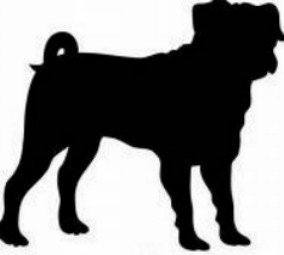

Doug's Pugs
Our Pugs are a fabulous dog but not without some health issues. First is the breathing issue. Pugs are brachycephalic ( have a short pushed in face) and tend to sometimes have breathing issues. Many times this can be attributed to weight. The problem is that pugs brought into Europe have developed different body styles depending on the location they came from. Pugs in the Dutch areas are the standard pug closest to the original Chinese pug as they where in the 15th centery. Just a little shorter and stockier than original. The English bred there pugs to be larger and so came the English pug which can be upwards of 35-40 pounds at normal weight. compared to the 18-24 lbs fro the standard pug. The Germans and Swedish breeders went for a smaller slender pug that ran from 11-15 lbs. has a wedge shaped face and thinner legs with small paws. When the pugs came to America all bets where off. Pugs from different parts of Europe where breed together and all kinds of issue arose. But getting back to breathing issues and weight. The Standard pug can be a pound or two overweight with little issues but a mini who is 2 pounds over can be a problem. Keep your dog fit with a good diet and exercise. Play with your Pug or better yet Pugs. They do much better in pairs. Walks in temperate weather is great for you and your Pug, however be mindful of heat. Much over 80 degrees and limit there outside time to 20-30 minutes and always have water for them. I carry a collapsible bowl on my belt with a bottle of water.
Ears: Pugs get a buildup of brown wax in their ears. If not cleaned they will get infected. Also they are prone to ear mites and in season ticks. Clean their ears once a week and check for ticks and sours that might be mites. There are commercially available mite drops that you can use to clean the ears but remember to use a drying agent after cleaning. Wrinkles and Folds: Our precious Pugs have folds in their faces that will collect dirt and should be cleaned at least once a week or best every two to three days. A damp q-tip works wonders and will keep irritation and infection away.
Fleas: Our worst nightmare. It is rare our Pugs get fleas as we do not normally have dogs on either side of us. But on occasion they will have friends with dogs over and it seems ours always wind up with fleas. One preventative measure we found works quite well and does not involve pesticides. Spread a layer of diatomaceous earth around the perimeter of your yard. It will kill the fleas (and ants and most other insects) by binding up their joints and making it impossible for them to move. And it will not harm our Little ones. Hip Displacia, and Arthritis: Pugs are prone to these ailments. As they get older the Arthritis can be controlled with medication. The hip displacia you have to work on. Check with your vet for the best course of action if any is needed.
Bladder Stones: Pugs are prone to bladder stones that are usually attributed to dairy in their diet. It seems Pugs can not process the calcium in dairy and it winds up building stones in their bladder. So even though they love it do not feed them cheese or any dairy product.
Ears: Pugs get a buildup of brown wax in their ears. If not cleaned they will get infected. Also they are prone to ear mites and in season ticks. Clean their ears once a week and check for ticks and sours that might be mites. There are commercially available mite drops that you can use to clean the ears but remember to use a drying agent after cleaning. Wrinkles and Folds: Our precious Pugs have folds in their faces that will collect dirt and should be cleaned at least once a week or best every two to three days. A damp q-tip works wonders and will keep irritation and infection away.
Fleas: Our worst nightmare. It is rare our Pugs get fleas as we do not normally have dogs on either side of us. But on occasion they will have friends with dogs over and it seems ours always wind up with fleas. One preventative measure we found works quite well and does not involve pesticides. Spread a layer of diatomaceous earth around the perimeter of your yard. It will kill the fleas (and ants and most other insects) by binding up their joints and making it impossible for them to move. And it will not harm our Little ones. Hip Displacia, and Arthritis: Pugs are prone to these ailments. As they get older the Arthritis can be controlled with medication. The hip displacia you have to work on. Check with your vet for the best course of action if any is needed.
Bladder Stones: Pugs are prone to bladder stones that are usually attributed to dairy in their diet. It seems Pugs can not process the calcium in dairy and it winds up building stones in their bladder. So even though they love it do not feed them cheese or any dairy product.